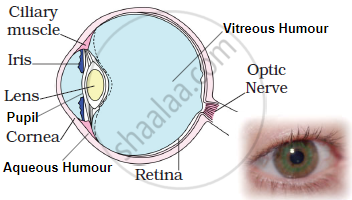Advertisements
Advertisements
Question
Draw a labelled sketch of the human eye.
Solution

APPEARS IN
RELATED QUESTIONS
Give the scientific names of the following parts of the eye:
changes shape to focus a picture on the retina.
The descriptions of five kinds of images are given below:
(a) diminished and virtual
(b) enlarged and real
(c) enlarged and erect
(d) real and inverted
(e) virtual and the same size
Which one of these describes the image formed:
(i) on the retina of the eye?
(ii) by a magnifying glass?
(iii) by a convex driving mirror on a car?
(iv) by a plane mirror?
(v) on the screen of a slide projector?
Fill in the following blank with suitable word:
Having two eyes gives a ................field of view.
Note the relationship between the first two words and suggest the suitable word/words for the fourth place.
Cones : Iodopsim :: Rods : ______.
Mention, where in living organism is the following located and state their main function:
Fovea centralis
Define the following:
Yellow spot
Complete the paragraph by choosing the right options given below.
(minimum, near point, 25 cm, farthest, farthest distance, far point)
The _______ distance of an object from a normal eye, at which it is clearly visible without stress on the eye, is called the minimum distance of distinct vision. The position of the object at this distance is called the _______ of the eye, for a normal human eye, the near point is at _______. The _______ distance of an object from a human eye, at which it is clearly visible without stress on the eye is called _______ of distinct vision. The position of the object at this distance is called the _______ of the eye.
The innermost layer of human eye is ______.
Match the following:
| Column - I | Column - II |
| 1. Retina | a. Pathway of light |
| 2. Pupil | b. Far point comes closer |
| 3. Ciliary muscles | c. near point moves away |
| 4. Myopia | d. Screen of the eye |
| 5. Hypermetropia | f. Power of accommodation |
With reference to human eye answer the question that follow:
Name the part of the eye associated with the regulation of the size of pupil.
